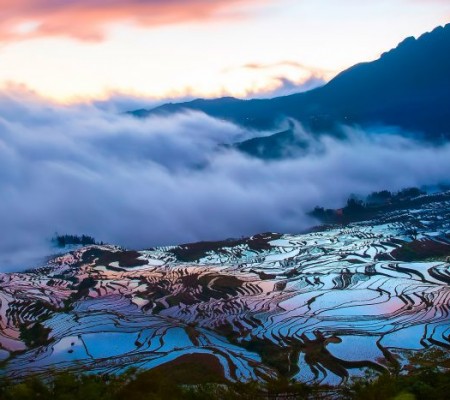
History of Kawa Karpo Meili Snow Mountain in Diqing
Kawagarbo (卡瓦格博), the highest peak of the Meili Snow Mountain (梅里雪山) range at 6,740 meters, has been worshipped as a sacred mountain by Tibetan Buddhists for over 1,300 years. As one of the eight holy mountains in Tibetan Buddhism, it holds deep spiritual significance in the local Kagyu (噶举) tradition.
Early Historical Records
The mountain first appeared in historical texts during the Tang Dynasty (唐代) when Tibetan King Songtsen Gampo (松赞干布) designated it as a sacred Buddhist site. The 17th century saw the establishment of pilgrimage routes that continue to this day.
Mountaineering History
Despite its spiritual status, Kawagarbo (卡瓦格博) attracted mountaineering attempts:
- 1902: First recorded attempt by British expedition
- 1987-1996: Multiple Japanese-Chinese joint expeditions failed to summit
- 1991: Deadliest accident when 17 climbers perished in an avalanche
- 2001: Chinese government banned climbing to respect local beliefs
Cultural Significance
The mountain features prominently in:
- Tibetan Buddhist scriptures
- Local folklore and oral traditions
- Annual pilgrimage ceremonies like the Kangkar (转山) circumambulation
Natural Preservation
In 2019, the Diqing Prefecture (迪庆州) government established strict conservation measures to protect the mountain’s fragile ecosystem while respecting its cultural importance.
Modern Recognition
- 1986: Listed as a provincial nature reserve
- 2003: Included in the Three Parallel Rivers (三江并流) UNESCO World Heritage Site
- 2020: Officially recognized as a “Holy Mountain” under Chinese law
The history of Kawagarbo (卡瓦格博) reflects the harmonious coexistence of natural wonder, spiritual tradition, and cultural preservation in the Diqing (迪庆) region.

 7 Days GolfingTour
7 Days GolfingTour
 8 Days Group Tour
8 Days Group Tour
 8 Days Yunnan Tour
8 Days Yunnan Tour
 7 Days Shangri La Hiking
7 Days Shangri La Hiking
 11 Days Yunnan Tour
11 Days Yunnan Tour
 6 Days Yuanyang Terraces
6 Days Yuanyang Terraces
 11 Days Yunnan Tour
11 Days Yunnan Tour
 8 Days South Yunnan
8 Days South Yunnan
 7 Days Tea Tour
7 Days Tea Tour
 8 Days Muslim Tour
8 Days Muslim Tour
 12 Days Self-Driving
12 Days Self-Driving
 4 Days Haba Climbing
4 Days Haba Climbing
 Tiger Leaping Gorge
Tiger Leaping Gorge
 Stone Forest
Stone Forest
 Yunnan-Tibet
Yunnan-Tibet
 Hani Rice Terraces
Hani Rice Terraces
 Kunming
Kunming
 Lijiang
Lijiang
 Shangri-la
Shangri-la
 Dali
Dali
 XishuangBanna
XishuangBanna
 Honghe
Honghe
 Kunming
Kunming
 Lijiang
Lijiang
 Shangri-la
Shangri-la
 Yuanyang Rice Terraces
Yuanyang Rice Terraces
 Nujiang
Nujiang
 XishuangBanna
XishuangBanna
 Spring City Golf
Spring City Golf
 Snow Mountain Golf
Snow Mountain Golf
 Stone Mountain Golf
Stone Mountain Golf











